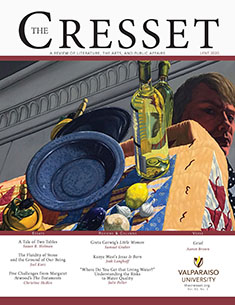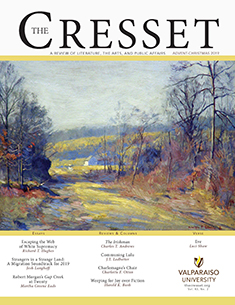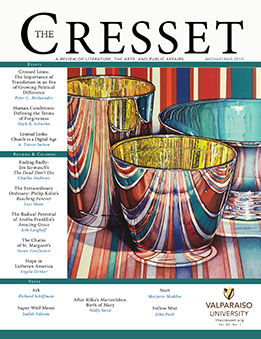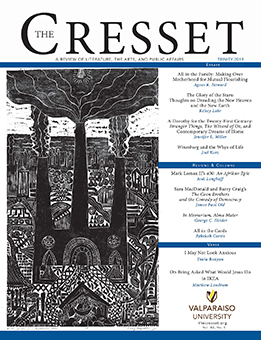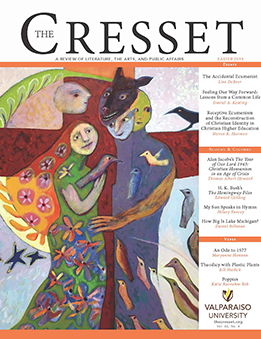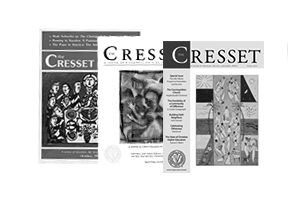To get to Quarry Farm, you head out of Elmira, accelerating up the old Watercure Hill Road, over cratered asphalt heavily weathered by the cold winters, through old forest and tangled weeds growing as high as camels; then take a sharp left onto Crane Road and toward the top of an overlook into the scenic Chemung River Valley several miles below. Up here, one is perched over a glorious scene: though not precisely mountainous, the massive geological features in the distance seem too pronounced to be called mere hills by my southern Indiana sensibilities. On the horizon I count five or even six layers of further hill-mountains, in varying shades of smoky blue and purple, scattered onward into the distance, usually graced as well with layers of mist and cloud. Among those layers somewhere is the distant border into Pennsylvania, though I don’t know where; I just know that I can see into the next state, because the natives have told me so.
Nestled into the tiny valley below them is the mid-sized town of Elmira, home of the well-to-do Langdon clan of pre-Civil War days, one of whom, Jervis Langdon’s pretty and petite daughter Olivia (or Livy), after a very long series of events and a rather charming courtship ritual mostly played out in letters, agreed to marry one Sam Clemens of Missouri. In 1867 Sam had met Livy’s brother Charley on a long ocean voyage to Europe and the Holy Land and had been shown a miniature portrait of Charley’s beautiful sister. As the story goes, Sam fell in love on the spot with Livy, right then and there aboard the ship as it was anchored in the Mediterranean Sea at the Bay of Smyrna. As one critic has put it, Livy was the beauty who tamed the ornery beast from the Wild West.
I feel honored to be invited here, in late summer of 2009, as a “Quarry Farm Fellow”: entrusted with the keys and allowed to sleep for seven days on the very premises where Twain, Livy, and their three rambunctious daughters summered for over twenty years. During those warm, idyllic months in the 1870s and 80s, Mark Twain, utterly freed from the rigors of platform touring or the various other business and authorial duties that constantly surrounded him back in Hartford, felt released to do much of his most famous and influential writing. His sister-in-law Susan Crane had built for him the famous octagonal study, now situated down the hill smack dab in the middle of the campus of Elmira College. Back in those halcyon days, Twain’s study, where he would go early in the morning and return at dinner time, sat some two hundred yards or so further on up the hill, away from the house, with its general hubbub, the boisterous games of the girls, the various activities of cooking, cleaning, gardening, sewing, and the chit chat of the extended family (including the cats, who often spoke in the tales the father spun for his daughters). There in that octagon Sam sat, penning long sections of some of the most dazzling works of the American spirit—most of the ones by which his acclaim continues to this day, the ones I need not even name.
This past year, as countless commemorations have taken place throughout the land in honor of the one-hundred-year anniversary of his death in April, 1910, it is good that we take a moment to consider Mark Twain’s achievements a century later. Many were the fruit of Quarry Farm, and the best place to catch the spirit of this historic place is on the massive, tiled front porch of the house, where the old rocking chairs are painted white, and the verdant lawn sweeps away like a large royal carpet rolled down the distant slope. (Granted, the porch was greatly expanded in the 1880s, and was originally wooden, but it still just feels right, very nineteenth-century.) Twain had one of the most formative experiences of his adult life on the porch: his encounter with his African American cook Mary Ann Cord, the one recorded “word for word” in the tale entitled “A True Story,” about the struggles she met as an ex-slave and mother whose son was lost and then restored to her during the course of the Civil War. The narration of Mary’s woeful tale took place right out here, on the steps leading up onto the porch, where each morning I take my coffee and read aloud from the dusty old volumes still in the shelves of the front parlors.
Reading aloud is one of the lost arts of the American nineteenth century, unfortunately. After a daylong struggle to write chapters for his latest book, hidden away in the monastic study built just for him and his concentration, Twain would stroll back down the hill, to read aloud to his family his newly-penned compositions that evening after supper. It was both an entertainment and a testing out of his plots and language. So Twain spent his evenings reading the day’s work, often on that same porch: first drafts of Tom Sawyer, Life on the Mississippi, The Prince and the Pauper, and various tales and sketches. He gloried in the civilized gentility of the Victorian family that hung on his every word. And despite those closing words of Huckleberry Finn, when Huck tells us he wants out of civilization (“I been there before”), by the time Mark Twain came under the sway of the Langdons, he did indeed wish to learn from the experts what it meant to be civilized. It was precisely at that moment in his life that Twain might have agreed with something Marilynne Robinson wrote over a century later in her masterpiece Gilead: “I miss civilization, and I want it back.” As it turned out, those restful times up there on Crane Road were the happiest and most “civilized” days of his life.
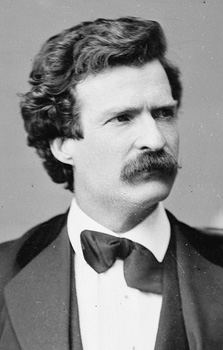
An emblem of the genteel, socially Christian civilization that Twain was in fact secretly longing for is this place in which I am now encamped, Quarry Farm, comfortably seated here on top of a luxuriant hill above Elmira. Directionally, it’s the story of a southern boy who longed to be welcomed into a northern family; but it is also the story of a western boy wanting to break into the elite companies of the East. Either way, there were some tough hierarchical geographies confronting Sam. Even today, many Americans wrestle with similar directional insecurities and arrogances at work in their own lives (including me, an aging hayseed from the Hoosier State). It’s probably not an overstatement to say that Mark Twain was plagued by assorted anxieties throughout his adult life, among which both his southerness and westerness counted very highly as some of the most prominent. From up here on top of what’s known locally as East Hill, Twain would have sat on the porch looking vaguely both south and west, as if to study those former haunts of his from the staid and secure Northeast.
My week here at Quarry Farm commenced on a Saturday night in the dog days of August—dog days back in St. Louis, that is, which is my home most of the year. I was in attendance at the quadrennial “State of Mark Twain Studies” conference, hosted by Elmira College for four days every four years, and featuring most of the top Twain scholars from America and around the world, with a few literary stars thrown in (Russell Banks, Hal Holbrook). As I boarded my plane in St. Louis early on Thursday morning the sixth, the weather was humid and tipping near a hundred degrees, but once I landed and arrived here, those dogs had been muzzled and trained—it was a breezy eighty degrees with little humidity. The dorms they stationed us in were not air-conditioned, so the dips into the low sixties at night were a blessed relief. Already I felt welcomed and encouraged by Mother Nature’s respite in the tangled terrain of what’s called locally the “Southern Tier,” meaning the counties west of the Catskills that border Pennsylvania to the south. I know Twain felt similar respite, as he hurried away from the dismal Hartford heat.
Three days of academic panels, plenary lectures, exhibitions, and an assortment of good food and Finger Lakes wine (they produce some nice, crisp, dry Rieslings and Chardonnays up in these parts) led inevitably to the final evening of the conference proper: an elaborate barbeque on the grounds of Quarry Farm itself, served under tents, picnic style. Much of it was food Twain would have loved: grilled chicken, ribs, macaroni salad, greens, corn bread, corn on the cob, and lots of cold beer. Guitars, mandolins, and a banjo made appearances, and songs were heard echoing through the woods. The skies deepened first into a pinkish glow, then blues and purples. Finally, it was time to head up the hill to the location of Mark Twain’s study: a tradition of the conference, a benediction of sorts.
Several dozen of us stood in a large set of concentric circles. Cigars were brought out and lighted in the darkness. Soon enough, a few of us began to sing old songs, ones that Mark Twain might have enjoyed listening to, and some of which he even sang himself: “Swing Low, Sweet Chariot”; “The Circle Will Be Unbroken.” Finally, after some minor prompting, Hal Holbrook agreed to tell some stories about his meetings, late in their lives, with Clara and Nina, the lone surviving daughter and granddaughter of Sam Clemens’s clan. Mr. Holbrook was gracious and spoke with élan and poignancy, especially about Nina’s alcoholic haze and despondency at the end of her rather lonely life, having long been abandoned by her feisty mother. Nina died in a dingy motel near Hollywood, having sold much of her birthright to a gambler. It was a very sad way for the living descendents of Mark Twain to pass into the oblivion of history, one that would have broken his heart, if indeed it were possible for that old tired heart to be broken yet again.
“The Circle Will Be Unbroken” was a particularly apt tune, I think. The professional society of which we are all members is, in fact, called The Mark Twain Circle. We stood on that hilltop in the dark, puffing our stogies, in loose circles within circles, pledging to one another that we might return here four years hence, to reenact our fondness for this great American icon. Let that circle remain unbroken, we sang. The eye is the first circle, said Emerson, many years ago. And we pledged to circle up again, come 2013.
But as everyone else packed their bags for an early departure the next morning, I was simply relocating to that haunted farmhouse just down the hill, for a week’s solitude.
This morning I’ve been thinking about the name of the place: Quarry Farm. It’s located up here next to an actual, once-productive limestone quarry. I spent almost fifteen years in southern Indiana, the limestone capital of the world, and I feel right at home in an area that supplies massive blocks of primordial stone for the erection of urban edifices across North America. Proud, even, to be reminded of the products of my youthful setting. I was in Bloomington when they filmed Breaking Away, back in the 1970s, and if you haven’t seen this charming, though somewhat dated, tale of bicycle racing, you may wish to add it to your Netflix queue, just so you can see those luminous scenes filmed at the old quarries south of town: deep, rectangular-shaped pits in which rainwater accumulates and where I remember going to swim with some of my buddies, as depicted in the film, back in the days when laws were looser and regulation less ornery. Local legend had it that some of the older quarries were hundreds of feet deep, if not bottomless. We would leap off the high boulders into the cool refreshing waters, then climb out and do it again, then lie like snakes on those warmed slabs in the summer sunshine, carefree as Tom and Huck skipping school (which we did sometimes as well, though in my own case it was college lectures in organic chemistry, Heidegger, or French New Wave film).
Those memories of the old Indiana quarries and the rocks hereabouts at Quarry Farm have been jarred by my visits to other sites in the neighborhood, for I’m noticing that this area of New York State has some resemblance to the hilly hollows and bottomlands of southern Indiana. The greatest resemblance, though, is the presence of the beds of rock, which are the firm foundation of the region. Outcroppings are everywhere, as are cascading waters rushing off toward Lake Ontario, and the residual shale and sandstone that break off the gorges and gather at the bottoms. It’s emphatically quarry country, all right, home to both ornamental stones and cornerstones, bluestone and soapstone. It’s good to remember that back in the nineteenth century, before northeasterners had even heard of Yosemite or Yellowstone, most of upstate New York was considered to be one massive, pristine land of mystery and abundance, a place of daring, featuring the Adirondacks and other assorted glacial remains running off into the Finger Lakes: the very edge of savagery. Its archetypal heroes included Cooper’s masterful Natty Bumppo—the mythic Leatherstocking—and his trusty sidekick Chingachgook, as well as Uncas, the Last of the Mohicans. These legendary men, and others of their ilk, settled these untamed lands, blanketed with what Longfellow famously described in The Song of Hiawatha as the “primeval forest.” It’s still possible to get a strong taste of what remains of that massive forest, but of course nowadays, with all the roads and traffic and tourists and everything that goes with them, it’s hard to keep in mind how wild this area of New York State must have seemed back in the 1870s. Underneath it all was the stone.
Wildlife is all around: birds especially, but yesterday I startled a large, portly woodchuck, who scurried away into the undergrowth. Squirrels perform their acrobatics all around me as I walk the woods. They often include me in their inter-family squabbles, as they scream back and forth like irritated neighbors in ethnic neighborhoods. Chipmunks streak by, always in a hurry. Deer and even bear are sometimes seen on the grounds of Quarry Farm; I suspect that 140 years ago they were in far greater abundance. At night, the bats come out, zigzagging around for their brunch. And then there are the mosquitoes—they seem to be having an abundant year, one to remember. Life luxuriates at Quarry Farm.
Once Clemens wrote about Livy, “wherever she was, there was Eden.” Quarry Farm was an Edenic experience for him and his family, and besides the wildlife there were the many domesticated creatures—horses, donkeys. Twain told the story of how his daughter Jean once stood enraptured by the cows silently munching in the meadow. And of course there was the Clemens’s brood of oddly-named cats: Fraulein, Stray Kit, Sourmash, Blatherskite; and finally Satan, the cat whose name perhaps reminded them that even in Paradise one must be watchful.
Paradise. That is what the family often called this place. Paradise evokes a sense of rest and wonder that illuminates much of Mark Twain’s greatest writing—that special something about being on a raft, for example, or those wonderful scenes in A Tramp Abroad where he encounters the Alps for the first time. Twain wrote Following the Equator, his final travel book, late in life, after his complete financial failure forced him to undertake an international lecture tour for financial reasons. Despite all the past and coming storms, we find once more in these reminiscences that special sensibility of transcendent joy, one that Twain was able to capture even then:
Indeed, the Island Wilderness is the very home of romance and dreams and mystery. The loneliness, the solemnity, the beauty, and the deep repose of this wilderness have a charm which is all their own for the bruised spirit of men who have fought and failed in the struggle for life in the great world....
I do not know how a day could be more reposeful: no motion, a level blue sea; nothing in sight from horizon to horizon; the speed of the ship furnishes a cooling breeze; there is no mail to read and answer; no newspapers to excite you; no telegrams to fret you or fright you—the world is far, far away; it has ceased to exist for you—seemed a fading dream, along in the first days; has dissolved to an unreality now; it is gone from your mind with all its businesses and ambitions, its prosperities and disasters, its exultations and despairs, its joys and griefs and cares and worries. They are no concern of yours anymore; they have gone out of your life; they are a storm which has passed and left a deep calm behind.
Such a spirit of “deep calm” permeated Quarry Farm for Sam and his brood: another sort of “Island Wilderness,” far, far away from it all, with nothing in sight from horizon to horizon, a “home of romance” perfect for the composition of a national mythos. It’s a bit of a wonder that Twain could write such lines as these so late in life, considering that he completed the manuscript of Following the Equator in those dark days of 1896–97 after the death of his daughter Susy. And yet the passages resound with a feeling of sublime peace and rest, a feeling, I would submit, that he found most regularly and predictably right here at Quarry Farm. And it’s a feeling I have grown to sense myself, all alone in this rocky, lush, near-island wilderness.
I visited Cornell University the other day, and the regal old campus sits atop a mountain much like the most scenic towns of the Italian Renaissance in Tuscany—Siena, San Gimignano, Cortona—the kinds of towns that oversee a landscape for miles around, and which can be seen from miles around; fiefdoms of incomparable local integrity and prestige. Cornell is a campus (not unlike Indiana in Bloomington, also raised from nearby quarries) featuring powerful, light-colored stone: its wise old buildings are ornamented with the products of local stonecutters. The campus is also protected by wide and raging waters tumbling down impressive sylvan gorges on both the north and south ends of the old campus, boundaries that are both moat-like and breathtaking.
As I crossed the pedestrian bridges into the oldest section of the Cornell campus, I knew I was entering another sort of space, a different country altogether, in the most special sense of what a campus used to mean in America. The campus features a very strong architectural motif of rockiness: benches shaped like outcroppings, running water through beautifully designed glades, and buildings covered in old minerals harvested from nearby fields. Perhaps in another five hundred years, should these buildings remain somewhat as they are today, it is plausible that crowds of tourists will come in their tour buses and wonder at the sheer awe and splendor of these grounds, as they do today in Siena. For now, at the beginning of the fall semester, the new students and their parents cling to maps of another sort. Earnest, sweaty fathers stroke their chins and wipe their brows, trying to find the right buildings, hoping to guide their children through the maze of college and into the pathways of the business or law professions. These harried, overweight, and well-invested men betray little sense of the historic weight confronting them on every side. As Mark Twain noted about travelers, they often fail to see the landscapes through which they are passing.
I like the fact that Quarry Farm, Mark Twain’s summer home, is named after the vaults of stony silence, that it gestures toward the solid rock of the region, as does the architectural splendor of Cornell. Twain did, in fact, see some of the same old structures I’m seeing this day: on at least two occasions he visited the Ivy League campus and became friendly with some of the local luminaries, including Cornell president Andrew Dickson White, university librarian Willard Fiske, and Cornell trustee and benefactor Henry Williams Sage.
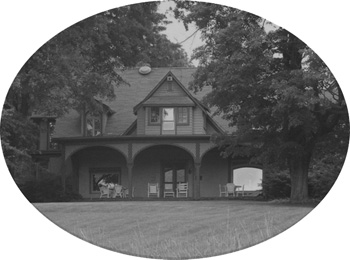
These kinds of stony places are foundational to who we are, or at least hope to be, as Americans. The rocks are from the basement of time, as Norman Maclean puts it at the end of A River Runs Through It, and underneath the rocks are the words. I suppose it is some of my Indiana heritage (or snobbery) coming out, but I like the primeval quality of this area, founded as it is on miles and miles of solid rock shelving that has been veiled from human sight for these millions of years. We have to dig deep, to uncover the words.
This morning the clouds are blanketing East Hill, and I can barely make out the first line of trees down the slope and toward the city. Beyond the two large sugar maples just off the porch, I can make out the few scattered trees inside the old stone wall, and perhaps another hundred feet downward, I can barely discern the forest edge, blurred and purple, a bruise within a cloud. The trees are ghostly, though the birds don’t seem to mind, as they wheel about, singing and cawing. Smaller swallows dip down to the ground, looking for manna. Somewhere an unidentifiable bird laughs in sharp peals; perhaps a northern flicker (I’d guess a loon, but I’m told they aren’t in this neck of the woods). Corvids caw twice, loudly, back and forth. The crows up here are startlingly huge, and they shout out like crabby longshoremen; they are said to be among our most intelligent birds, but they rarely act like it. Two woodpeckers pound away at trees, one on the left, just above me in the maple nearest to the porch, the other far off into the woods to my right.
Stereo woodpeckers, neither listening to his neighbor. Some jays are cackling on a low branch, down the hill. The fog moves lethargically; the sun releases more heat, and the day begins to clear, though I still can’t see the town. But suddenly, after going inside for a few minutes and returning, it is even foggier than before. A false start to a clear morning.
I want to get an early start to my morning work, and suggest strongly to myself that it’s time to head upstairs to the keyboard; but what’s the rush? “I have no promises to keep; and nowhere to go....” Another cup of coffee, and back out onto that splendid porch, to watch the local economy emerge from the fog.
This morning I tote down to the porch a copy of Twain’s “A True Story,” written in black dialect, to read aloud as I sip my coffee. I try to sound like an ex-slave. I have been saving this moment for near the end of the week; the tale’s genesis is arguably the most famous and the most decisive literary event ever to happen on these grounds. And it did happen, in fact—probably almost precisely as Mark Twain reports it. Mary Ann Cord, the black cook employed by the Cranes and at the service of the Clemens, and known to all as Auntie Cord, still rules the kitchen in the form of the small, framed photograph that hovers there to this day. She was born a slave in Virginia, probably in the 1830s, and one evening in the year 1873 Mr. Clemens (“Misto C”) asked her about her constant good mood: it made him wonder if she had ever seen hardships or struggles in life. This innocent question caught her fancy; evidently Mr. Clemens had no idea about the troubles she had seen in the old slavery days, and so she proceeded to let him know all about it.
The scene took place out on the porch, with Mr. and Mrs. Clemens seated just about where I sit every morning of my stay, and with Auntie Cord just below them on the steps leading down into the yard. As Twain recounts the tale in the “true story,” after his naïve query, Auntie Cord stood to her feet and began to instruct her brain-dead boss (Twain could always admit to his own ignorance) about the most dire problems she had faced, including the separation from her son. The broken-up family was a motif of slave motherhood made famous in a work by Twain’s Hartford neighbor Harriet Beecher Stowe: Uncle Tom’s Cabin. Losing a child signified the ultimate sacrifice for any God-fearing Christian woman. Auntie Cord had, indeed, seen it all before.
“A True Story” was a tale of deep anguish, and Mark Twain hurried to put it all down on paper almost as soon as Auntie Cord finished telling it. That piece first appeared in the Atlantic Monthly, the premiere eastern establishment publication that would launch Twain into the far reaches of America’s upper crust literary establishment—the sad tale of an ex-slave woman lamenting her lost son, delivered in black dialect. More importantly, it signaled the changing attitudes of a southerner to the misfortunes and abuses of African Americans. The story Auntie Cord shared with “Misto C” that evening on the porch at Quarry Farm had some fairly powerful long-term consequences for her listener, and through him for the story of American literary history. In effect, “A True Story” jumpstarted the process of Twain’s growing sympathy for the marginalized members of society, including blacks. And it all began right here, on this very porch, tiled with local stones. (Though it seems an historical shame that back then, it was still wooden.)
If Twain’s most influential work was composed in that hilltop octagon a couple hundred paces from the main house at Quarry Farm, I can see why. The proof in the pudding is the restful times I was allowed to enjoy up here myself. All week the phone rang only once in the house (sadly, a credit card company, one of those thoroughly depressing recorded voices). A car passes on the road about once an hour. At night, it is dark in the way that city slickers like me hardly ever experience darkness. Besides the happy crickets, it’s quiet, too. Lately the Perseids are kicking in: meteors streak by, the residue of the Swift-Tuttle Comet, named shortly after the Civil War. More primeval stones, falling on this land of stone. That old snow-cone circles our sun about every 130 years or so, and the meteor showers commence as the earth passes through its hoary trail once a year. The remnants of that ancient comet are dazzling though somber, reminding me that Sam, in one of the great coincidences of American history, was born during one appearance of Halley’s Comet, and then died seventy-five years later during its reappearance. He even predicted that latter event: he prophesied that he was going out with Halley’s Comet. I lie on the lawn at Quarry Farm, late at night, staring up at the cloudy skies, searching for meteorites. Bats wing about, making sudden ninety degree turns, this way and that.
Tonight, staring up into the sky, I recall that all three of the Clemens girls were born right here in this house. The bodies of Susy, Livy, Jean, and Sam himself, were all laid out in the front parlor of the Langdon family home down the hill on Main Street in Elmira, across from the Park Church, with friends and family filing by, saying their tearful goodbyes. A century ago, homes were very commonly places of birth and of death. Nowadays, our houses rarely witness the birthing of children or the display of the dead, at least formally. We have hospitals and funeral homes for that sort of thing, and as such we are sequestered from the more primal scenes of our humanity. It distances those things, makes them seem less crucial to our lives, or less fundamental. Twain knew better, of course. This structure was a real home to him in the most primal ways, such as in the birthing of his precious daughters right here, which must have sealed in his mind its hallowed significance: the site where Livy shrieked and pushed as the little girls emerged, one by one, Sam somewhere off in another room or out in the woods, waiting.
My first time up here, I was told by one of the local hands that this old house is haunted, and maybe it is.
My wife Hiroko would certainly have enjoyed the time here in Elmira, but she was back in Japan visiting relatives: her sister and her aging parents. It is “O-Bon” season back in Japan—the season for returning to the place of the ancestors and recalling their spirits. Remembering and honoring the dead. Asians seem to venerate their lost ancestors to a far greater degree than postmodern Americans can ever really understand, and it is one of the many things about the Japanese that I truly admire.
There are many festivals in Japan during the O-Bon season, both in big cities and tiny villages. Most commonly, walking the streets during this period, one comes upon bon-dori—traditional dances performed by large numbers of Japanese celebrants, most of them wearing the summer garb called yukata: light linen robes. Sometimes, in towns along rivers and on a specific night, one finds paper lanterns glowing with lighted candles inside of them, gently floating downstream toward the sea—luminous reminders of the spirits hovering nearby. O-Bon is family oriented: families clean their houses and offer food. Lanterns are lighted to show the way home; incense fills the air. A key goal of O-Bon activities is to invite the spirits back and to enhance the serenity of their ongoing reality—to ask for peaceful repose for them.
So, as my wife has been remembering the dead back in Japan, along with her family, so have I been doing the same up here on top of East Hill, overlooking the town of Elmira. Here, the souls of the dead seem near. At night, the sounds of this old creaky house are very much the same sounds heard by the Clemens clan, hunkering down for the night, as papa planned his next day of writing, about prodigal sons, runaway slaves, pretty young blonde girls, sleepy preachers, unkind schoolmasters, shady Indians, and weathered con men plying their trade up and down the old river. I lie in the bed, imagining those who lay here over a century ago, and I feel content. And with a sort of blessed assurance, in my mind’s eye I replay the ending of the conference, when we all stood in a circle singing, on the site of the octagonal study, remembering our own beloved dead:
I was standing by the window
On a cold and cloudy day
When I saw the hearse come rolling
To carry my mother away.
Will the circle be unbroken?
Bye and bye, Lord, bye and bye
There’s a better home a waiting
In the sky, Lord, in the sky.
I left Quarry Farm refreshed, rejuvenated, and full of the same wonder that inspired Sam Clemens, the healing waters he discovered annually here in the Southern Tier. Watercure Hill, indeed. There may well be a better home a’waiting, bye and bye, in the sky. But for now, this home was good enough.
Hal Bush is Professor of English at Saint Louis University and author of Mark Twain and the Spiritual Crisis of His Age (University of Alabama Press, 2007) and the forthcoming Lincoln in His Own Time (University of Iowa Press).


